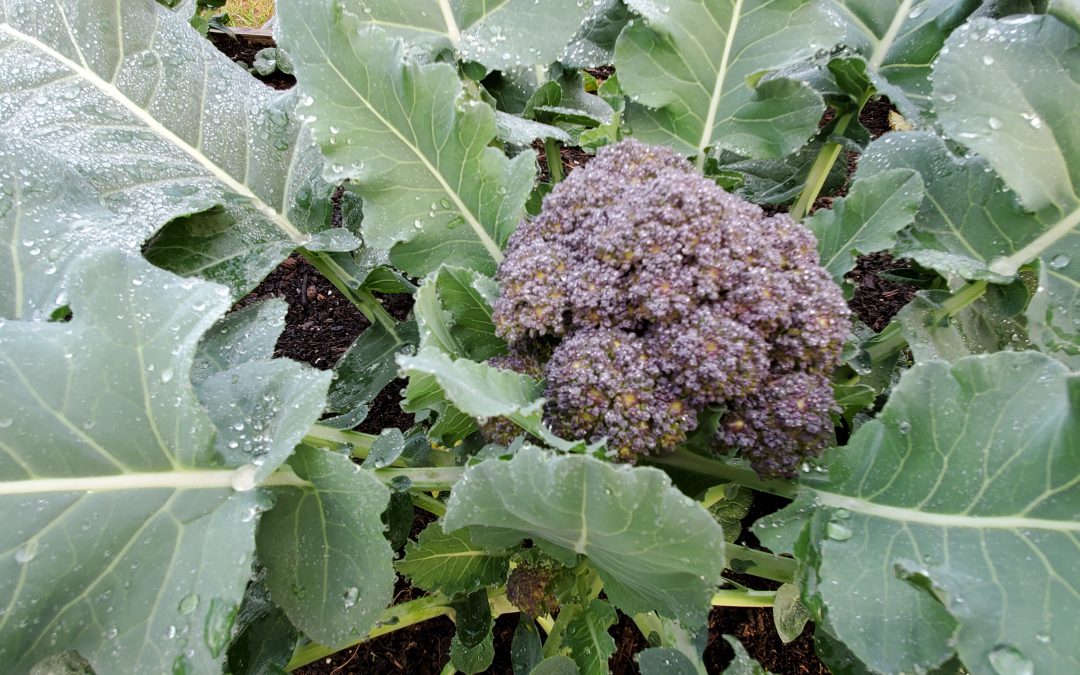
by Daniel J. Leonard | Jan 23, 2020
Cruciferous vegetables, mostly cool-season annuals in the Brassicaceae (formerly Cruciferae) family, are part of a healthy diet, prized for their high fiber content and unique sulfur-containing compounds known as glucosinolates. This vegetable family includes things many of us love (or love to hate) like Brussels sprouts, cabbage, cauliflower, collards, kale, mustard, turnips, bok choy, and Chinese cabbage. They’re also commonly grown in Panhandle gardens. However, as anyone who has grown these species knows, some are easier than others. For example, kale and radish are among the easiest of all plants to grow. But get beyond the basics and folks often run into difficulty with species like broccoli and cabbage. The high rainfall/humidity and frequent warm spells experienced here during the growing season often lead to serious pathogen problems, dooming my garden in years past. However, this winter, thanks to a couple of new cultivars, ‘Capture’ Cabbage and ‘Burgundy’ Sprouting Broccoli, I’ve enjoyed a plentiful supply of tasty crucifers!
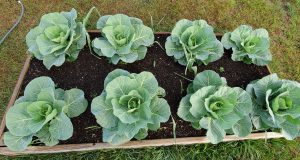
4’x 8′ raised bed planted with ‘Capture’ on 24″ centers.
‘Capture’ Cabbage, developed by Bejo Seeds of California as a mid-season “white” fresh market cabbage for the South, has been an outstanding performer in my garden this year. Touted as highly resistant to Black Rot and Fusarium Yellows (by far the two most devastating pathogens of Cabbage), I had to try it for myself. I planted seeds 24” apart in my standard 4’ wide x 8’ long x 12” deep raised beds filled with mushroom compost and aged pine bark. Seedlings were fertilized once about three weeks after germination with a general purpose 10-10-10 fertilizer. The plants that developed have been extremely vigorous (I’m glad I paid attention to plant spacing guidelines on the seed packet!) and have not shown ANY evidence of disease, even through an unusually warm and wet winter that would have hammered older susceptible varieties. My plants have begun to develop heads and should be ready for harvest and the kitchen in just a couple more weeks! If you’ve had problems getting a cabbage from germination to head formation and harvest without serious disease pressure, give ‘Capture’ a try next fall!
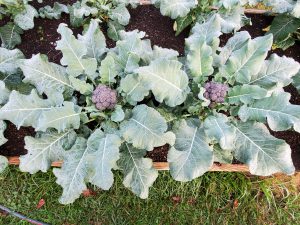
‘Burgundy’ Broccoli in the author’s raised bed garden.
‘Burgundy’ Broccoli, developed by Elsom Seeds in the United Kingdom, is a unique variety sure to turn heads in your garden. True to its name, the prolific florets are a deep, purple color. Though the central “head” on ‘Burgundy’ is quite small, that’s not the primary feature anyway. Considered a “sprouting” broccoli, this cultivar puts out an abundance of side shoots that make ‘Burgundy’ sort of a cut-and-come-again broccoli, allowing for a long harvest window. Another advantage from a disease avoidance perspective is the short maturity time (the time from planting seeds to having harvestable shoots) of around 40 days! For perspective, a “regular” heading broccoli has a maturity of around 60 day, lots more time for problems to happen. In the same growing conditions described above for cabbage, ‘Burgundy’ performed amazingly well for me, growing strong, healthy stalks, large, unblemished leaves and an abundance of purple shoots with a nice flavor profile!
If you want to enjoy homegrown broccoli and cabbage but disease pressures have made your previous efforts unproductive, give ‘Capture’ Cabbage and ‘Burgundy’ Broccoli a try! These two selections have made it easier than ever to enjoy unique, homegrown, healthy cruciferous veggies. Keep these and other quality, disease-resistant cultivars in mind when planning your winter garden in 2020!
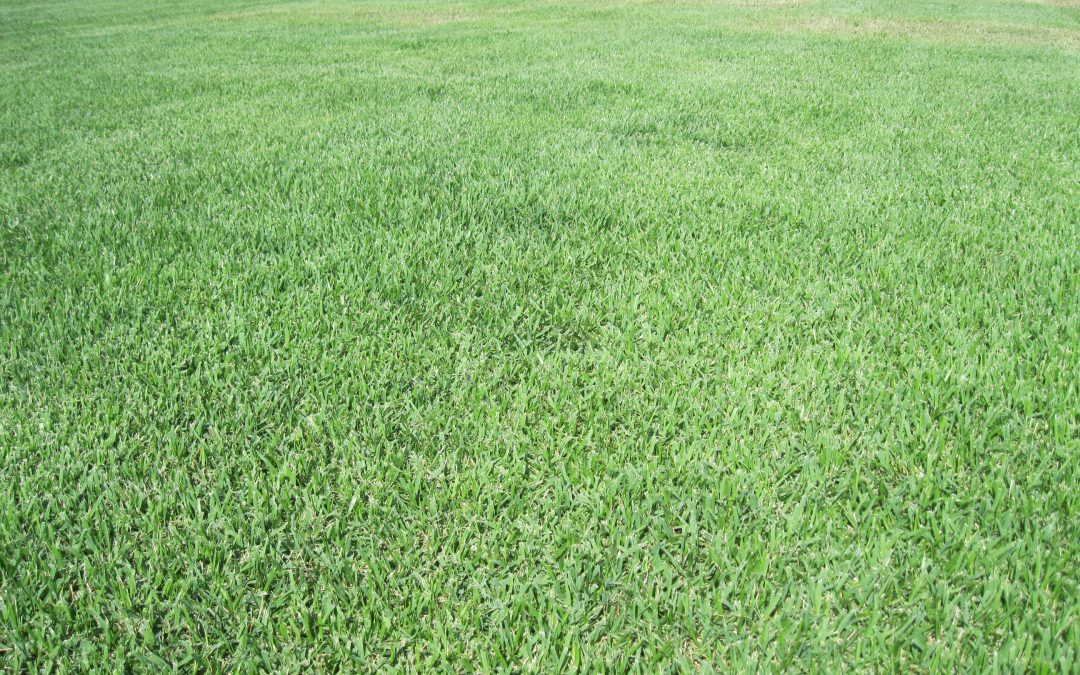
by Ray Bodrey | Aug 22, 2019
Seldom do we find the answer to a problem as being easy. More often, a difficult and complicated answer is what’s needed. However, the solution to a healthy lawn rebound may be found simply by adjusting your mower height and mowing schedule.
Mowing strategy is an important variable that keeps a lawn healthy and flourishing, no matter the species or cultivar of grass. Mowing too high can lead to an undesirable look and cause unwanted thatch buildup, which can create a favorable environment for pests and diseases. Mowing too low can weaken the root system causing thinning, which allows space for weeds to invade. Another problem with mowing too low is that it affects nutritional needs. Lawn grasses generate food for themselves through a process called photosynthesis. A healthy leaf surface area is needed to effectively accomplish this. If the lawn is mowed too low, then leaf surface area is lost. The grass can literally starve itself.
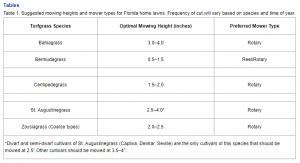
Table: Suggested mowing height for lawn grasses. Frequency of cut will vary based on species and time of year. Credit: L. E. Trenholm, J. B. Unruh & J. L. Cisar, UF/IFAS Extensio
Not all lawn grasses should be mowed at the same height, as show in the table above. Fine textured grasses like Bermuda and Zoysia matrella can be cut significantly lower than coarse textured grasses, such as Bahia or St. Augustine. Not sure of the type of lawn grass you have? Visit this site https://edis.ifas.ufl.edu/topic_book_florida_lawn_handbook_3rd_ed to review the Florida Lawn Handbook or contact your local county extension office for questions.
Mowing schedule is the other side of the coin. How often to mow ultimately depends on how fast your grass grows. By nature, Bermuda will grow quickly and Zoysia is somewhat slower growing. Regardless, summer months are when warm-season lawn grasses grow more rapidly. Historically, lawn grasses begin a dormant-slow growth stage in October and continues through March. Fertilizer schedule also plays a role in grass growth rate. So how often do you need to mow? This rate is best determined by the amount of growth since the last cutting, rather than the number of days which have elapsed. You should mow often enough so that no more than 1/4 to 1/3 of the total leaf surface is removed at any given mowing. In other words, leave twice as much leaf surface as you cut off. Remember, incremental adjustments should be made to your current practices. Never drastically change the height of the grass. If the lawn has been allowed to grow too long, you should gradually lower the mowing height on successive cuttings.
What are some other helpful tips? Always use a well-adjusted mower with a sharpened blade. You may find it easier replace your blade each year or every 2 years than periodic resharpening. Dull mower blades do a tremendous amount of damage with uneven cuts. This will cause gashes and splits in the leaf where fungal and bacterial pathogens can thrive. Never mow grass when it’s wet, either. Dry grass cuts are cleaner cuts and won’t clog the mower deck. If you have built up thatch, it’s a good idea to attach a bag to your mower that will catch clippings. These clippings will be great additions to your compost pile or to use as natural mulch. If no thatch problems exist, mowing without a bag will distribute clippings throughout the lawn, and the clippings will decompose into nutrients for the root system.
With proper mowing strategies, along with fertilizing & watering, your lawn grass can bounce back. For more information contact your local county extension office.
Information for this article provided by the UF/IFAS Extension EDIS Publication, “Mowing Your Florida Lawn”, by L. E. Trenholm, J. B. Unruh & J. L. Cisar: https://edis.ifas.ufl.edu/pdffiles/LH/LH02800.pdf
UF/IFAS Extension is an Equal Opportunity Institution.
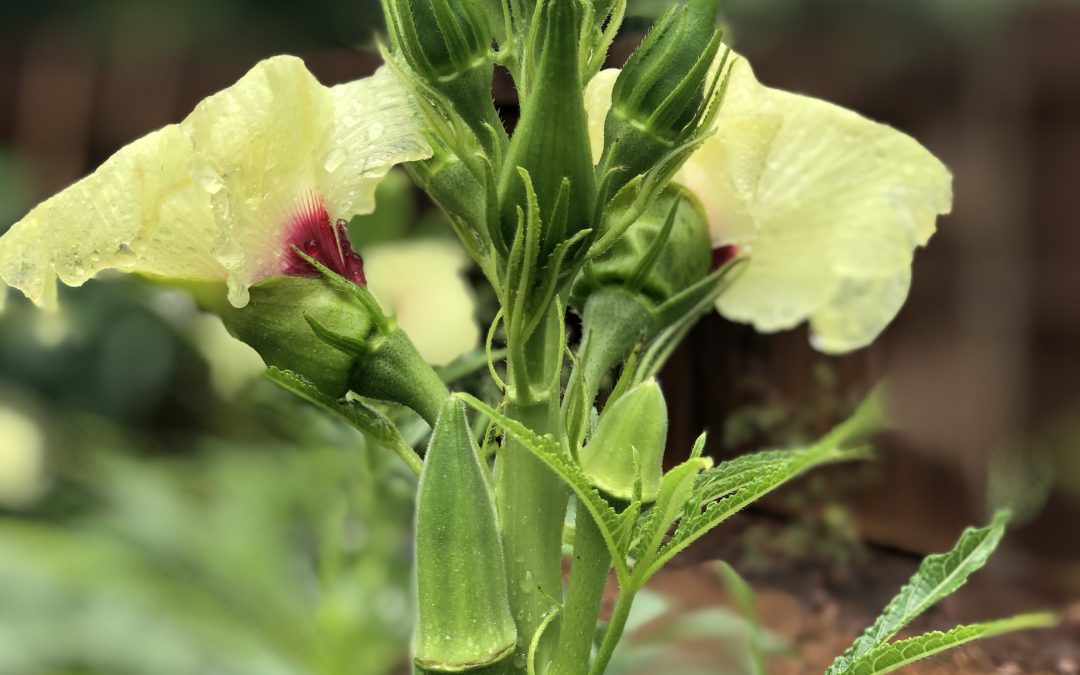
by Daniel J. Leonard | Aug 20, 2019
Though Okra (Abelmoschus esculentus) fruit isn’t much more than a thick green hull, slime and seeds and the plant itself is impossibly irritating to the skin, few plants are as integral to Southern heritage. In my mind, okra is among the best vegetables Panhandle gardeners can grow. Not only is it a gorgeous plant – Okra belongs to the Mallow family which also includes beauties like Hibiscus and Cotton – but it’s exceedingly versatile in the kitchen, excellent fried, grilled, roasted, boiled (though you have to acquire a taste for slimy textures to enjoy this method) and most famously, as a thickening agent in Cajun gumbo. Because of this exalted status in Southern culture, whether you enjoy eating okra or not, it’s almost mandatory here to include the plant in one’s garden. Most gardeners stick with the old standard varieties such as ‘Clemson Spineless’ or ‘Cowhorn’ and there is nothing wrong with them, however, these plants are almost too prolific for most gardens (growing upwards of 6-7’), especially for those of us growing in the close confines of raised beds. In the search for a less rambunctious but still ultra-productive cultivar, this summer I trialed ‘Jambalaya’, an F1 hybrid developed by Sakata Seed in 2012, with impressive results!
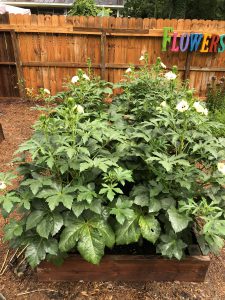
‘Jambalaya’ Okra in the author’s garden.
From my experience growing the cultivar this summer, ‘Jambalaya’ merits consideration in the garden, and is a must for raised bed gardeners, for two primary reasons. First, it was bred to be compact and is considered a dwarf cultivar. This is an awesome attribute, as I typically end the growing season picking okra from a small ladder! Most seed purveyors tout the plant as reaching a maximum height of 3-4’ and while this estimate might be a little conservative, I can attest that ‘Jambalaya’ is greatly reduced in height compared to the standard cultivars. The second advantage of growing this variety is that it begins producing very early relative to its peers and bears heavily. ‘Jambalaya’ fruit begin to ripen in about 50 days, about ten days to two weeks earlier than ‘Clemson Spineless’, a definite advantage if rotating behind a late maturing spring crop like potatoes as I typically do. Though ‘Jambalaya’ is a dwarf plant, in no way are yields reduced. My specimens have produced continuously since late-July and will continue to do so as long as adequate fertility and consistent harvesting are provided.
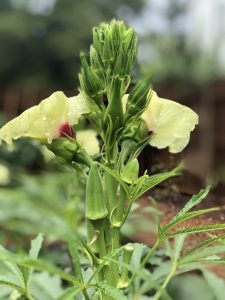
‘Jambalaya’ flower & fruit production.
Like any other okra cultivar, ‘Jambalaya’ has a couple of basic requirements that must be met for plants to thrive. In general, all okra cultivars love Southern summers and patience sowing seed is recommended, allow the soil to warm to at least 70 degrees before planting. Okra also prefers full sun, at least 6 hours per day, any less and yields will be reduced and plants will stretch towards the light. Belonging to the Mallow family, okra requires consistent moisture, particularly when in the flowering and fruiting phase. Finally, it is critical to keep up with your okra harvest as the plants produce! Okra pods grow quickly and should be harvested when they are no more than 3-4” long and still tender, larger pods are tough to the point of being inedible!
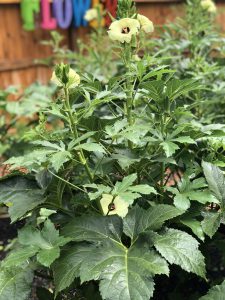
‘Jambalaya’ in the author’s garden.
Whether you’re new to the okra growing game or you’re a seasoned gumbo gardener, I highly encourage you to give ‘Jambalaya’ Okra a look next summer. While ‘Jambalaya’ is available through many seed sources, Johnny’s Selected Seeds sells a conveniently small package perfect for backyard gardeners, though they’ll be happy to provide larger quantities as well. In ‘Jambalaya’ you’ll find a nice compact plant that won’t outgrow your space, provide you a summer long harvest of tender green pods, and will rival the ornamentals in your landscape for the title of prettiest plant on your property! Happy gardening and as always, if you have questions about vegetable gardening or any other horticultural or agronomic topic, please contact your local UF/IFAS County Extension office!
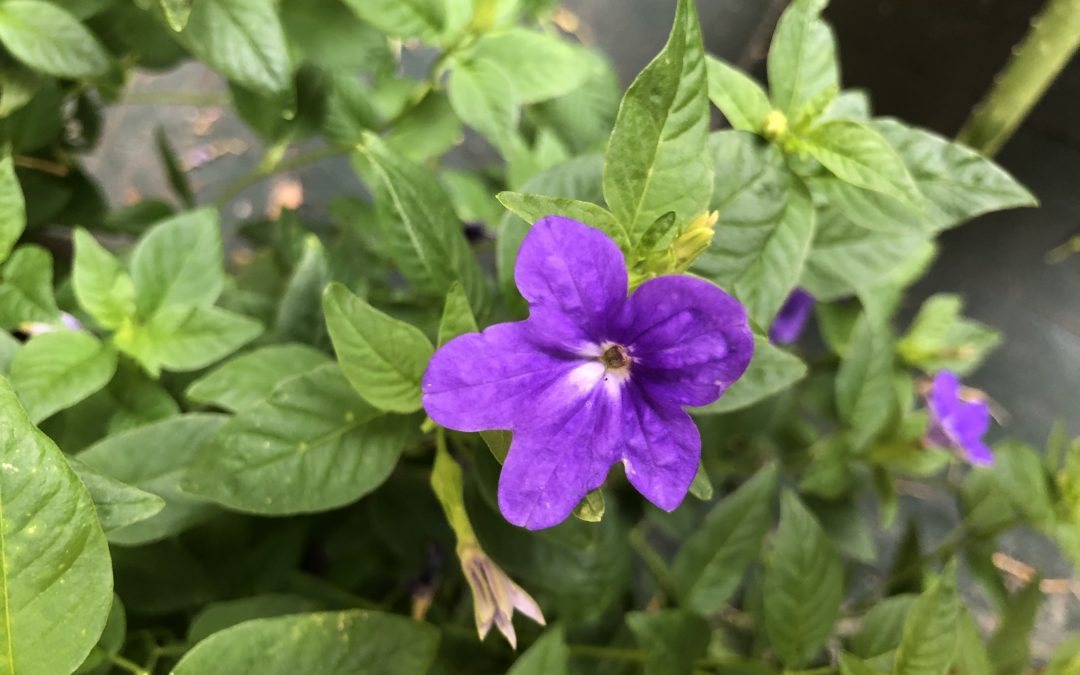
by Daniel J. Leonard | Aug 12, 2019
As an unabashed plant enthusiast who’s been experimenting with new plant introductions (some not really “new”, just new to me) in his own landscape, and his parent’s yard before that (sorry guys for the ‘Charmed Wine’ Oxalis that now pops up unwanted every spring) for nearly two decades now, at this point I’m pretty hard to impress. However, last year Andrea Schnapp, a UF/IFAS Walton County Master Gardener, introduced me to a newish plant that has since changed the way I choose plants to color shady pots and planting beds, a little native of tropical South America called Bush Violet (Browallia spp.), specifically the hybrid ‘Endless Illumination’.
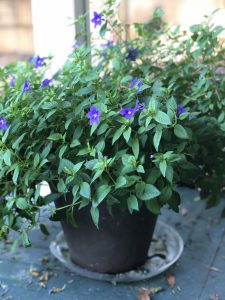
Browallia ‘Endless Illumination’ on the author’s back porch.
For decades, the standard bedding plant for color in the shade in the Deep South has been Impatiens walleriana. However, in the last few years, a new disease called Impatiens Downy Mildew has wreaked habit on the bedding plant species, virtually eliminating it as a serious player in the horticulture industry. Fortunately, the fine folks at Proven Winners introduced ‘Endless Illumination’ a couple of years ago to fill the niche formerly occupied by old-fashioned Impatiens. And boy, is ‘Endless Illumination’ aptly named. The unending masses of star shaped flowers are an absolutely brilliant purple hue that does indeed light up shady areas in the landscape. I’ve encountered few plants put forth such a proliferous display of flowers for as long of a time as this Browallia selection has, and it doesn’t even require deadheading!
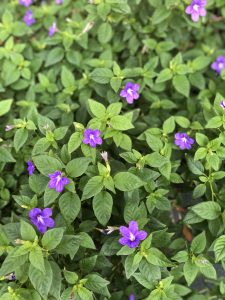
Browallia ‘Endless Illumination’ flowers.
In addition to having one of the more striking color displays of any bedding plant, Browallia happens to be a vigorous grower with an extremely hardy constitution. I’ve found ‘Endless Illumination’s mature size as listed on the sales tag as being a little conservative, instead of the 16” tall x 14” wide stated, my samples have consistently grown more than the 16” listed in height and doubled the width, no complaints here as this just means more flowers! And though my experience with Browallia has strictly been in containers so far, it has weathered heat and bounced back from drought like a champ. It’s not super important to know that the container it occupies is sited under my back porch roof and therefore is subjected to human induced drought by my forgetting to water it, good performance in droughty conditions is good performance in droughty conditions! Finally, Browallia requires the bare minimum of fertilizer to thrive. A good topdressing of a slow-release fertilizer (rates according to the product’s label, of course) at planting and an identical refresher dose mid-summer have induced great performance and no noticeable nutrient deficiencies.
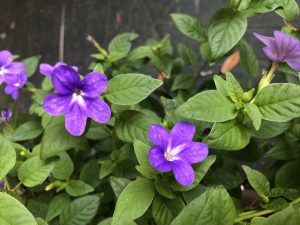
Browallia ‘Endless Illumination’ flowers
A quick note before we adjourn, when perusing nurseries next spring for Browallia, you’ll likely encounter the sister cultivar of ‘Endless Illumination’ with white flowers, named ‘Endless Flirtation’. I’d encourage you to stick with the purple flowers of ‘Endless Illumination’ as I’ve found, through personal growing experience and anecdotes from other growers, ‘Endless Flirtation’ to be noticeably fussier than and not nearly as attractive as its sister plant.
Sometimes, the misfortunes of one plant are a merely an opportunity for another plant to claim its place in the flower bed. Browallia ‘Endless Illumination’ has taken the spot occupied by Impatiens walleriana and quickly become a garden favorite. Look for this awesome little annual in garden centers next spring! And remember, if you have any questions about this newly introduced plant or any other horticultural topic, please contact your local UF/IFAS Extension office! Happy gardening!
by Daniel J. Leonard | Jul 20, 2018
Too often, would be gardeners travel to exotic locales, become intoxicated with the beautiful floral display of Plumeria, Jatropha, Bird of Paradise and Bougainvillea, and come home with visions of homemade leis picked from the garden dancing in their heads. As anyone who has attempted to grow any of the aforementioned plants in the Panhandle will tell you though, fulfilling those visions in the landscape are easier said than done! However, not all is lost for the gardener wanting to bring the tropics home. A tropical feel in the landscape can be achieved, you just have to look beyond the aforementioned flowering plants that will have long since succumbed to winter frost by the time they mature and begin flowering and instead to tropical foliage plants that can be enjoyed for a season and easily (cheaply too!) replaced the following spring. Of all the tropical foliage options available for Panhandle landscapes, my favorite is the Ti Plant, sometimes called Hawaiian Ti.
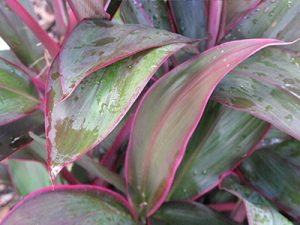
Ti Plant foliage
Even if you have never heard of Ti, you have probably seen it. The strap like, 12-18” long, purple and pink striped leaves are hard to miss and add an unmistakable tropical flair in the landscape! Ti Plants grow generally in single, unbranched stalks, though most commercial growers combine several plants into a single pot to give a bushy, multi trunked appearance that looks more appealing on a retail nursery bench. These plants will easily reach 4-6’ in height in a single warm season, providing a powerful punch of pink/purple all summer long. In addition to its considerable attractiveness, Ti boasts a cosmopolitan constitution, as it will grow in sun or shade, outside or inside. Of course, some cultural do’s apply to Ti broadly, regardless of where it is grown, as well as a few don’ts.
In general, Ti will be more colorful in brighter light. Though it grows well in shade, its leaves tend to lose their luster and fade to a dull purple in full shade. Similarly, though it will survive in full, all day sun, Ti’s foliage tends to bleach a bit in these conditions and can turn a whitish gray. It is best to shoot for somewhere in the middle for the most vivid foliage color. If growing indoors, give Ti as much light as you can. If growing outdoors, full sun through midafternoon is appropriate, as is bright shade throughout the day. Be sure to give Ti plants consistent moisture, as they will readily wilt down under prolonged drought conditions. As with watering, Ti prefers a consistently fertile soil and will appreciate a topdressing of a complete, slow release fertilizer (made by Osmocote, Harrell’s and others) at planting, with a follow up application 60-90 days later (possibly more frequently depending on temperature and frequency of watering).
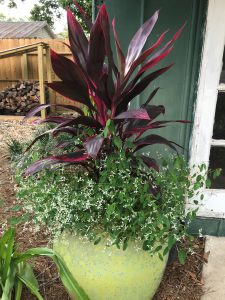
Ti plant in a mixed container – Photo Courtesy Daniel Leonard
Though Ti performs well planted in the ground in Northwest Florida as an annual specimen to brighten a border (think of it like a supersized Coleus), it really gets to shine in large, mixed containers. Ti’s upright growth habit and traffic stopping color make it the perfect thriller in the widely used “thriller, filler, spiller” container design. Because Ti can grow quite large relative to other common container plants, a large 20-45 gallon container is necessary to facilitate optimum root growth and plant development. If a smaller container is chosen, water management will become an issue as the Ti plant’s root mass will quickly crowd the container. I prefer glazed ceramic or concrete containers as these are often painted in bright colors that complement Ti’s foliage, do not allow as much air exchange as terra cotta planters (soil in terra cotta containers dry very quickly in hot, dry weather), and are heavy enough that tall Ti plants won’t cause them to blow over in windy conditions. Mix smaller, mounding filler plants and trailing spiller plants under and around Ti in containers. For a striking contrast in color, choose companion plants in white, yellow, orange or chartreuse (remember, plants don’t have to flower to be colorful, vivid foliage plants like coleus or caladium work too!).
Regardless of how you use Ti Plant, you’ll find it to be one of the most high value color plants in the landscape. Plant one today and happy gardening!















